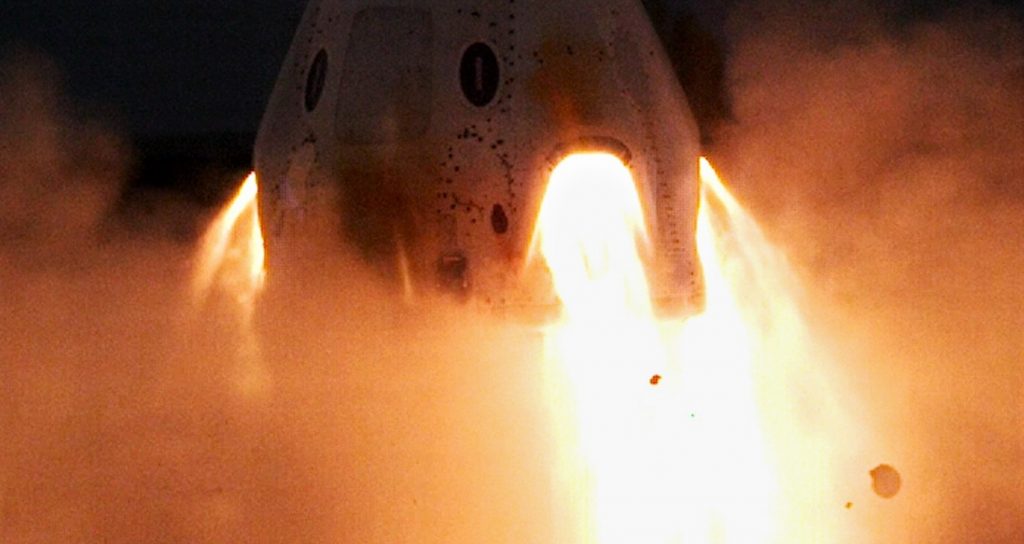NASA has formally given SpaceX permission for Crew Dragon’s second launch – a crucial test flight that should be the last before SpaceX launches NASA astronauts to the International Space Station (ISS) for the first time ever.
Known as its In-Flight Abort (IFA) test, Crew Dragon will attempt to escape a Falcon 9 rocket while airborne, a feat that CEO Elon Musk says will almost certainly destroy the rocket in the process. Technically speaking, NASA and SpaceX completed what is known as a Launch Readiness Review (LRR) sometime on Thursday, allowing SpaceX to proceed with launch preparations. By all accounts, Crew Dragon’s IFA test will likely be one of the most spectacular SpaceX launches ever, given that it is all but guaranteed to result in the intentional in-flight failure of a massive Falcon 9 rocket – “destroyed in Dragon fire” according to Musk.
Thanks to a much smoother launch flow compared to Crew Dragon’s Demo-1 orbital launch debut on Falcon 9, SpaceX’s newest Crew Dragon capsule is scheduled to lift off from Kennedy Space Center Launch Complex 39A (KSC LC-39A) as early as 8 am EST (13:00 UTC), Saturday, January 18th. The In-Flight Abort test will likely be one of Crew Dragon’s most challenging hurdles yet but success would be a major boon for the spacecraft’s demonstrated safety. While both Boeing and SpaceX will ultimately ferry NASA astronauts to and from the ISS, only SpaceX chose to prove Crew Dragon’s in-flight abort capabilities in the real world.
Effectively condemned to destruction to support a greater cause after a productive life, Falcon 9 Block 5 booster B1046 rolled out to Pad 39A – Crew Dragon mounted atop it – on January 16th after successfully performing its last routine static fire on the 11th. As previously discussed on Teslarati, B1046 is the first Falcon 9 Block 5 booster completed by SpaceX and is thus also the oldest flightworthy rocket in the company’s substantial fleet.
“After becoming the first SpaceX booster to launch three times in December 2018, B1046 spent several months at SpaceX’s Hawthorne, CA factory undergoing inspections and refurbishment. At some point, SpaceX assigned the thrice-flown booster to support Crew Dragon’s In-Flight Abort (IFA) test – effectively a death sentence – and shipped the booster to Florida, where it publicly appeared for the first time in months on October 3rd, 2019. Given that four more Falcon 9 boosters have now successfully performed three (or even four) orbital-class launches each, B1046’s now-imminent demise is certainly disappointing but remains extremely pragmatic.”
Teslarati.com — January 15th, 2020
As such, there is arguably no better booster for SpaceX to expend even if its loss is still less satisfying than a successful post-launch landing. In fact, aside from NASA’s prematurely-retired Space Shuttle, the entire history of orbital-class rocketry has effectively operated on the assumption that it’s both normal and necessary for rockets to be almost entirely expendable.
Only by sheer force of will has SpaceX turned that assumption on its head, making the act of expending Falcon 9 or Falcon Heavy boosters feel suddenly morose. Even then, the practice of propulsively landing orbital-class boosters is scarcely four years old, while reusing those boosters has been ongoing for less than three years. As such, B1046’s demise should be enjoyed for what it ultimately is: the spectacular retirement of a rocket that has already helped launch three separate payloads to orbit.
Perhaps even more importantly, B1046’s sacrifice should – if things go as planned – also pave the way for Crew Dragon to launch its first NASA astronauts into orbit just a few months from now. For the test to be successful, however, Crew Dragon will have to perform an extremely precise string of maneuvers – the failure of any one of which could potentially lead to the spacecraft’s destruction.
“Traveling as fast as Mach 2.5 (860 m/s) at an altitude of 28 kilometers (17 mi), Crew Dragon will ignite its abort thrusters and attempt to escape, the very act of which will likely hammer the spacecraft’s windward surfaces with an extra dozen or so metric tons (~25,000 lb) of aerodynamic pressure. Crew Dragon C205 could thus find itself traveling almost Mach 3 (more than a kilometer per second) moments after separating from Falcon 9, eventually reaching an apogee of almost 75 km (45 mi), after which it will reenter the bulk of Earth’s atmosphere and have to deploy an array of parachutes to ensure a gentle Atlantic Ocean splashdown.”
Teslarati.com — January 13th, 2020

Unfortunately, Crew Dragon escaping a supersonic Falcon 9 also means that that same Falcon 9 – basically a thin, flexible tube designed to be as light as possible – will meet a supersonic blast of air the moment Dragon’s SuperDraco abort thrusters ignite. A bit like if a hurricane on all kinds of meteorological steroids just sort of punched a soda can for fun, that airstream will almost certainly obliterate Falcon 9’s sacrificial upper stage into a sort of aluminum snow, quickly revealing – and likely then destroying – B1046’s carbon fiber interstage.
The rest of the thrice-flown Falcon 9 booster is also liable to break up after that supersonic punch. In fact, SpaceX engineers are so confident in B1046’s imminent demise that the booster will have neither landing legs or grid fins come launch. In a best-case scenario, if, against all odds, B1046 survives Dragon’s escape, the intact booster will subsequently impact the Atlantic Ocean at terminal velocity and become a nice, artificial reef off the coast of Florida. Stay tuned for updates from Teslarati and photographers Jamie Groh and Richard Angle as Falcon 9 B1046’s demise inches ever closer.
Check out Teslarati’s newsletters for prompt updates, on-the-ground perspectives, and unique glimpses of SpaceX’s rocket launch and recovery processes.

(adsbygoogle = window.adsbygoogle || []).push({});
<!–
–>
var disqus_shortname = «teslarati»;
var disqus_title = «NASA says SpaceX's Crew Dragon abort test is go for launch on doomed Falcon 9 rocket»;
var disqus_url = «https://www.teslarati.com/nasa-spacex-crew-dragon-abort-test-go-for-launch/»;
var disqus_identifier = «teslarati-126995»;

